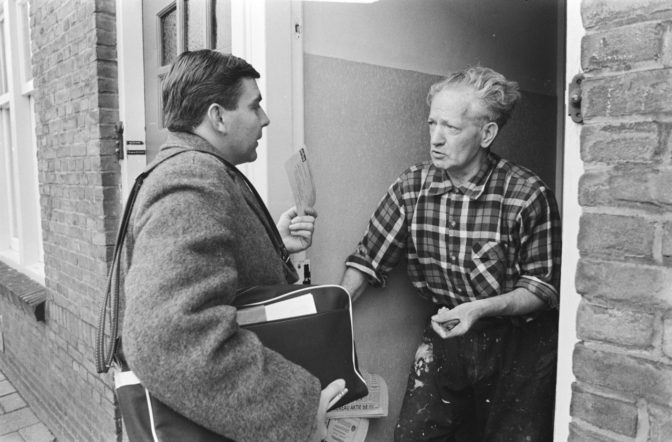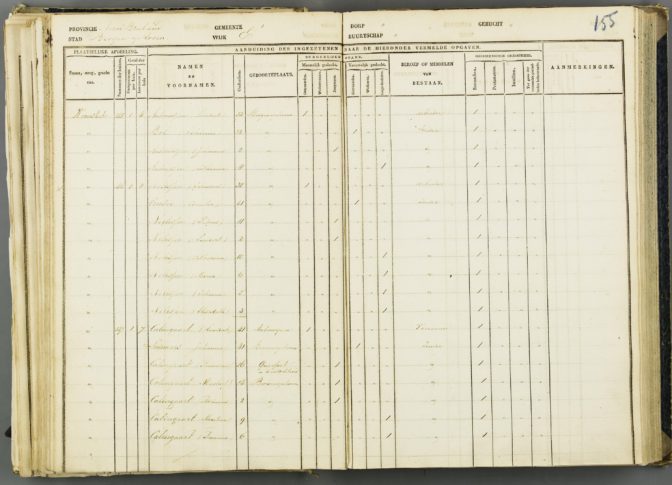The first nation-wide census of the Netherlands was held in 1795, during the French occupation. The first official Dutch census that recorded every individual was held in 1830 and was held every ten years.
In 1850, the population register was introduced to keep the population information up-to-date in between censuses. Initially, the census was used to verify and correct the population registers. With the introduction of digital record keeping, this was no longer necessary so the decennial census was abolished in 1991, twenty years after the final census was held.

Census taker in 1971. Credits: Rob Mieremet, collection Nationaal Archief (CC-BY)
List of censuses in the Netherland
- 1795: first nation-wide census during the French occupation. Many towns only tallied the totals and did not record individuals.
- 1830: first census to record individuals, including personal information such as marital status, religion and sex.
- 1840
- 1849: census expanded to include birth place and occupation.
- 1859
- 1869
- 1879
- 1889
- 1899: first census organized by the newly founded Centraal Bureau voor Statistiek (Central Bureau for Statistics).
- 1909
- 1919
- 1920
- 1930
- 1947
- 1956
- 1960
- 1971: last census.
Importance for genealogical research
Most Dutch genealogists I know rarely use census records. The 1830 and 1840 censuses are sometimes used to get an overview of who lived where in that period, or for very specific research problems. For example, while researching the father of a child born out of wedlock in 1831, I searched the 1830 census to see whom his mother was living with at the time.
For the period since 1850, genealogists typically use the population registers instead of the census records, since they provide a more complete picture since these records are not just a snap-shot, but show how the family changed over time.
Example: 1830 census of Bergen op Zoom
For example, let’s take a look at a page from the 1830 census record.
On the top of the page, we see that it is a page for the city of Bergen op Zoom in Noord-Brabant in the same-named munipality, ward E, no hamlet or village name, page 155. The page lists the residents of several houses on the Weverskat street/alley. The first four entries are for the residents of house no. 145, which houses one family consisting of four persons:
- Hendrik Antonissen, age 32, born Bergen op Zoom, a married male, laborer, Roman Catholic
- Johanna Bol, age 32, born Bergen op Zoom, a married female, without occupation, Roman Catholic
- Johannes Antonissen, age 2, born Bergen op Zoom, unmarried boy, without occupation, Roman Catholic.
- Catharina Antonissen, age 8, born Bergen op Zoom, unmarried girl, without occupation, Roman Catholic.
The 1830 census does not specify what the relation is of these people to the head of the household, but the composition of a household consisting of a married male, a married female and two young children suggests that Hendrik Antonissen and Johanna Bol were married and the parents of Johannes and Catharina. Such assumptions can be verified in other records, for example by searching for the birth records of the children or for the marriage record of the parents.
Where to find census records
The 1795 census can normally be found in the records of the French government, which are kept at the regional historical center in the capital of the province. These are rarely available online.
Census records from the 1830s onwards can typically be found in the town records in municipal or regional archives. Some of these archives have indexed and digitized their records and made them available on their own websites and/or through WieWasWie.
Some census records have also been digitized and are available online at Familysearch, in the Netherlands Census and Population Registers set. This record set is not indexed.
To find out if the census records for the town where your ancestors lived are available online, check the Digital Resources Netherlands and Belgium website.
Sources
- “Volkstelling,” Wikipedia (https://nl.wikipedia.org/wiki/Volkstelling : version 3 January 2016 23:04).
- Centraal Bureau voor Statistiek, Volkstellingen 1795-1971 (http://volkstelling.nl/ : accessed 14 February 2016).
- Bergen op Zoom, Volkstelling 1830, p. 155, ; “Bladeren in Bronnen,” digital images, West Brabants Archief (http://www.westbrabantsarchief.nl : accessed 17 August 2016), call number 83, record group boz – 0032, image 155.



Thanks very much, Yvette, for this very useful information.
It was a bit frustrating for me. Our family had an 1861 death and an 1862 birth in the Westdongeradeel records in Friesland, but Alle Friezen does not include Westdongeradeel, so that I do not know which town in the Westdongeradeel 1860-1880 Bevolkingsregister to search, since I can see only the abstracted information in Tresoar, which does not include the place of birth/residence.
Fortunately, the records are in alphabetical order within the town and not in house number order. So I was able to find them at https://familysearch.org/pal:/MM9.3.1/TH-1942-30151-3515-4?cc=2018408
Strictly speaking not censuses, but in 1811 and 1812/1813 under the French occupation the Registre Civiques were compiled to get a better picture of which able men could be enlisted in the French Army. Although the results have been lost for many places those that have survived have been transcribed by the Dutch Genealogical Society (NGV). Version 2.0 was published around 1999. I am not sure whether all surviving RC’s have been transcribed.